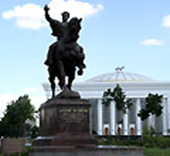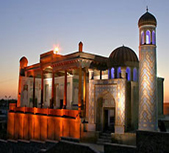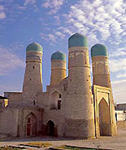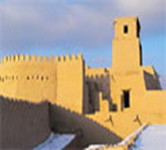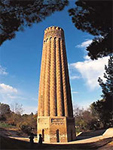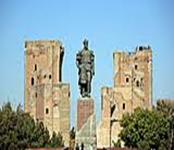|
Категории
|
Khiva
Khorezm or Khwarizmi, "The country of the sun", was considered a historical and cultural center with a large number of ancient settlements, as an example Tuprak Kala, Kyrkkyz Kala, Kuykyrylgan Kala, Hazorasp, Khiva and others. There are already 4,000 years ago created a powerful system of irrigation for agriculture. There are reports of ancient authors about the contacts with the peoples of Khorezm, people of Colchis on the trade routes of the Amu Darya and the Caspian Sea, which were Central Asian and Indian goods in the possession of the Caucasus through the Black Sea. Khiva - it is one of the oldest cities in Asia, which was founded in V century BC For centuries, the Silk Road crossing Central Asia and linked East and West. On the origin of Khiva and its name, there are many folk tales. One legend attributes the foundation of the biblical son of Noah, Shem. It tells that after the Flood, Shem, wandering in the desert once asleep, he dreamed 300 torches. When he awoke, he was happy omen that the city and created with the outline in the form of a ship, according to the location of his dream of torches. Then Sim dug a well "Kheyvak", after whom the city was named Khiva. The location of buildings in the form of a ship, and up to now existing in the center of the well "Kheyvak" connects the myths about the origin of Khiva with the real facts of the present day.
According archeological data, Khiva was founded over 2,500 years ago. In ancient times the city was known as Kheyvak. In his history of the Achaemenid conquest of the city experienced periods of prosperity, and when the borders of ancient Khorezm extended to Colchis.
From 305 to 995 year Khorezm, which consisted of Khiva, ruled the Afrigids dynasty. In 712, the Khiva was invaded by Arabs under the command Kuteyba ibn Muslim. After that, Khiva became part of the Muslim world. Despite the dependence on the Arabs Afrigids retain power by the end of the tenth century. In the years 995-1017 Khorezm ruled the Mamunids dynasty. In 1017 Khorezm was depending on the Ghaznavids state.
In early 1220 the army of Genghis Khan invaded the territory of Central Asia. In February this year was taken Bukhara, in March - Samarkand, in the fall - Termez, and in April 1221 - Gurgandj. After the death of Genghis Khan in 1227, the entire Mongol Empire was divided into several independent states were headed by the sons and grandsons of Genghis Khan. North-west of present Uzbekistan - Khorezm became part of the Jochi Ulus - the Golden Horde. In the middle of the XIV century extends into the political arena Amir Temur, who became later the creator of one of the largest states in the history of the East. Five times Tamerlane made trips to Khorezm, but only in 1388 he managed to win it all.
The heyday as the capital of Khiva, the construction of a set of monumental architectural structures occurred in the XVIII - beginning of XX century, when rules the Uzbek Kungrat dynasty, founded by Muhammad Amin. Kungrat dynasty rule in the Khiva Khanate until 1920.
In the early twentieth century, Khiva deployed substantial construction works, which were organized by the vizier Islam Khoja. For example, was built by the famous Minaret that bears his name, which became one of the main symbols of the city.
In 1991, Uzbekistan declared its independence. Now Khiva - a city in the Khorezm viloyat (region) of the Republic of Uzbekistan, on the right had won the title of "City-museum". City - a place of pilgrimage for tourists from all over the world. The face of modern Khiva forms mainly the architecture of Khiva Khanate period late XVIII - early XX centuries. In contrast to Samarkand and Bukhara, in the Khiva entire medieval town, square and all of its streets, as well as almost all architectural monuments are concentrated in the so-called inner city - Ichan-Kala, and stored in its original form. Ichan-Kala included in the list of protected World Heritage Site by UNESCO.
|
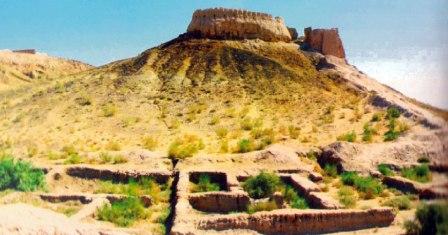 The history of Khiva is closely linked with the history of Khorezm and its many significant political, social, economic and cultural events.
The history of Khiva is closely linked with the history of Khorezm and its many significant political, social, economic and cultural events.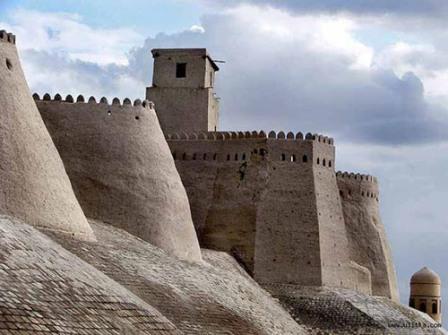 Khiva suffered numerous historical and climatic adversities. Source of Life in Khorezm - deep river Amu Darya. Khiva was not originally the capital of Khorezm. Historians say that in 1598, the Amu Darya has receded from the former capital of Urgench (formerly Gurgandzh). Amu Darya, flowing through the territory of the khanate, flowed into the Caspian Sea in the old riverbed, known as the Uzboy, providing residents with water, as well as providing a water route to Europe. For centuries, the river changed its course dramatically several times. The final turn of the Amu Darya at the end of the XVI century ruined Gurgandj. At a distance of 150 km from the modern Khiva, near the settlement of Kunya Urgench (the territory of Turkmenistan), which means "Old Urgench" are the ruins of the ancient capital.
Khiva suffered numerous historical and climatic adversities. Source of Life in Khorezm - deep river Amu Darya. Khiva was not originally the capital of Khorezm. Historians say that in 1598, the Amu Darya has receded from the former capital of Urgench (formerly Gurgandzh). Amu Darya, flowing through the territory of the khanate, flowed into the Caspian Sea in the old riverbed, known as the Uzboy, providing residents with water, as well as providing a water route to Europe. For centuries, the river changed its course dramatically several times. The final turn of the Amu Darya at the end of the XVI century ruined Gurgandj. At a distance of 150 km from the modern Khiva, near the settlement of Kunya Urgench (the territory of Turkmenistan), which means "Old Urgench" are the ruins of the ancient capital.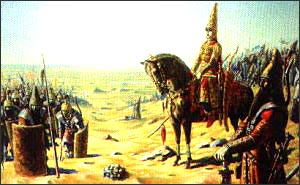 In the middle of VI BC Persians invaded in Khorezm, led by king Cyrus, and Cyrus himself was killed in battle with the nomads - Massagets, led by Queen Tomiris. According to legend, Tomiris ordered to cut off the dead Cyrus's head and dip it in a bag filled with blood to sate its bloodthirsty enemy. In the V-IV centuries BC Khorezm is seeking independence from the Persians. With the IV-III centuries BC Khoresmian known writing system, the royal residence - Toprak-kala, the ancient mausoleum, a temple and an observatory - Koi-Krylgan-kala.
In the middle of VI BC Persians invaded in Khorezm, led by king Cyrus, and Cyrus himself was killed in battle with the nomads - Massagets, led by Queen Tomiris. According to legend, Tomiris ordered to cut off the dead Cyrus's head and dip it in a bag filled with blood to sate its bloodthirsty enemy. In the V-IV centuries BC Khorezm is seeking independence from the Persians. With the IV-III centuries BC Khoresmian known writing system, the royal residence - Toprak-kala, the ancient mausoleum, a temple and an observatory - Koi-Krylgan-kala.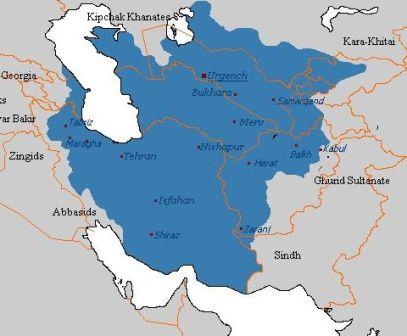 In the first half of the XI and XII century Khorezm was part of the Seljuk state. In the XI century begins the gradual rise of Khorezm, which is closely linked with the policy of the Turkic dynasties Khorezm-shahs Anush-tegin. Grandson of Seljuk princes Anush-Tegin - Atsyz took the title of Khorezm-shah, and declared the independence of Khorezm. The cunning diplomat and a strong military leader, he began to pursue an independent foreign policy. His son Il-Arslan and grandson Tekesh greatly expand the limits of the state, adding to it the territory of modern Turkmenistan and the entire eastern Iran. In 1195 Tekesh does defeated the troops of Abbasid caliph, and Khorezmian troops enter to Iraq as a sovereign masters. Son of Tekesh, Muhammad succeeded in defeating Kara-kitais (nomads from western China) and Ghurid (dynasty in Afghanistan). Then he wins the whole of Iran and Afghanistan. As a result of these military successes had created the most powerful state in the Middle East - the state with its capital in Gurganj (now Old Urgench). State of Khorezm-shahs in 1220 ceased to exist. The decisive blow in the fall of his power caused the Mongol army led by Genghis Khan.
In the first half of the XI and XII century Khorezm was part of the Seljuk state. In the XI century begins the gradual rise of Khorezm, which is closely linked with the policy of the Turkic dynasties Khorezm-shahs Anush-tegin. Grandson of Seljuk princes Anush-Tegin - Atsyz took the title of Khorezm-shah, and declared the independence of Khorezm. The cunning diplomat and a strong military leader, he began to pursue an independent foreign policy. His son Il-Arslan and grandson Tekesh greatly expand the limits of the state, adding to it the territory of modern Turkmenistan and the entire eastern Iran. In 1195 Tekesh does defeated the troops of Abbasid caliph, and Khorezmian troops enter to Iraq as a sovereign masters. Son of Tekesh, Muhammad succeeded in defeating Kara-kitais (nomads from western China) and Ghurid (dynasty in Afghanistan). Then he wins the whole of Iran and Afghanistan. As a result of these military successes had created the most powerful state in the Middle East - the state with its capital in Gurganj (now Old Urgench). State of Khorezm-shahs in 1220 ceased to exist. The decisive blow in the fall of his power caused the Mongol army led by Genghis Khan.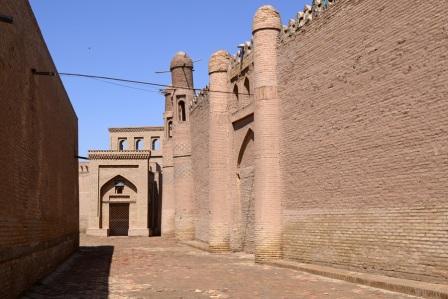 After the collapse of Timurid Empire in 1500 is part of the Khiva Khanate of Uzbek dynasty Sheibanids. In 1511 Khorezm, the lower reaches of the Syr Darya and part of modern Turkmenistan managed other related Sheibanids dynasty, founded by Sultan Ilbars, who becomes the ruler of the Khanate. In the 1596-1598 years Amu-Darya retreated from the former capital of Khorezm, Urgench (Gurganj) and the capital was moved to a new place to Khiva. Since that time the state began to call him the Khiva Khanate. At that time Khiva was a small fortified town with a 10th century history.
After the collapse of Timurid Empire in 1500 is part of the Khiva Khanate of Uzbek dynasty Sheibanids. In 1511 Khorezm, the lower reaches of the Syr Darya and part of modern Turkmenistan managed other related Sheibanids dynasty, founded by Sultan Ilbars, who becomes the ruler of the Khanate. In the 1596-1598 years Amu-Darya retreated from the former capital of Khorezm, Urgench (Gurganj) and the capital was moved to a new place to Khiva. Since that time the state began to call him the Khiva Khanate. At that time Khiva was a small fortified town with a 10th century history.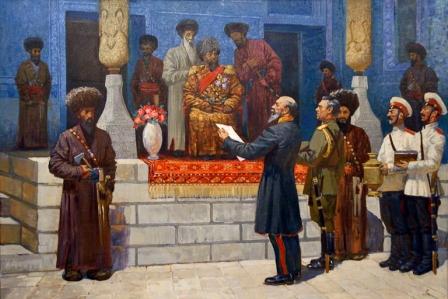 In the second half of XIX century begins a gradual expansion of the Russian Empire in Central Asia, where at this time there were three countries - the Bukhara Emirate, Kokand and Khiva Khanate. As a result of the fighting erupted, the Russian Empire annexed the part of the Khiva Khanate in 1873 during a major military operation under the command of the Governor-General Kaufman. Capital - Khiva was taken by Russian troops in June 10, 1873. Khiva Khanate received protectorate status, ie vassal state with the reduced territory and limited sovereignty.
In the second half of XIX century begins a gradual expansion of the Russian Empire in Central Asia, where at this time there were three countries - the Bukhara Emirate, Kokand and Khiva Khanate. As a result of the fighting erupted, the Russian Empire annexed the part of the Khiva Khanate in 1873 during a major military operation under the command of the Governor-General Kaufman. Capital - Khiva was taken by Russian troops in June 10, 1873. Khiva Khanate received protectorate status, ie vassal state with the reduced territory and limited sovereignty.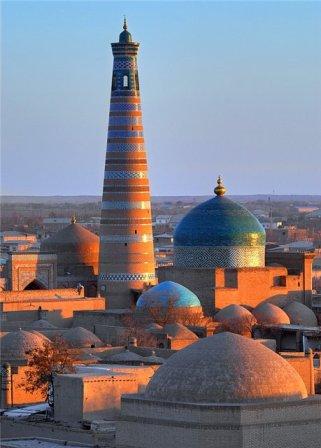 In 1919 the Red Army overthrew the last Khan. In 1920, Khiva became the capital of the Khorezm Soviet People's Republic, and in 1924 became part of the Uzbek SSR.
In 1919 the Red Army overthrew the last Khan. In 1920, Khiva became the capital of the Khorezm Soviet People's Republic, and in 1924 became part of the Uzbek SSR.